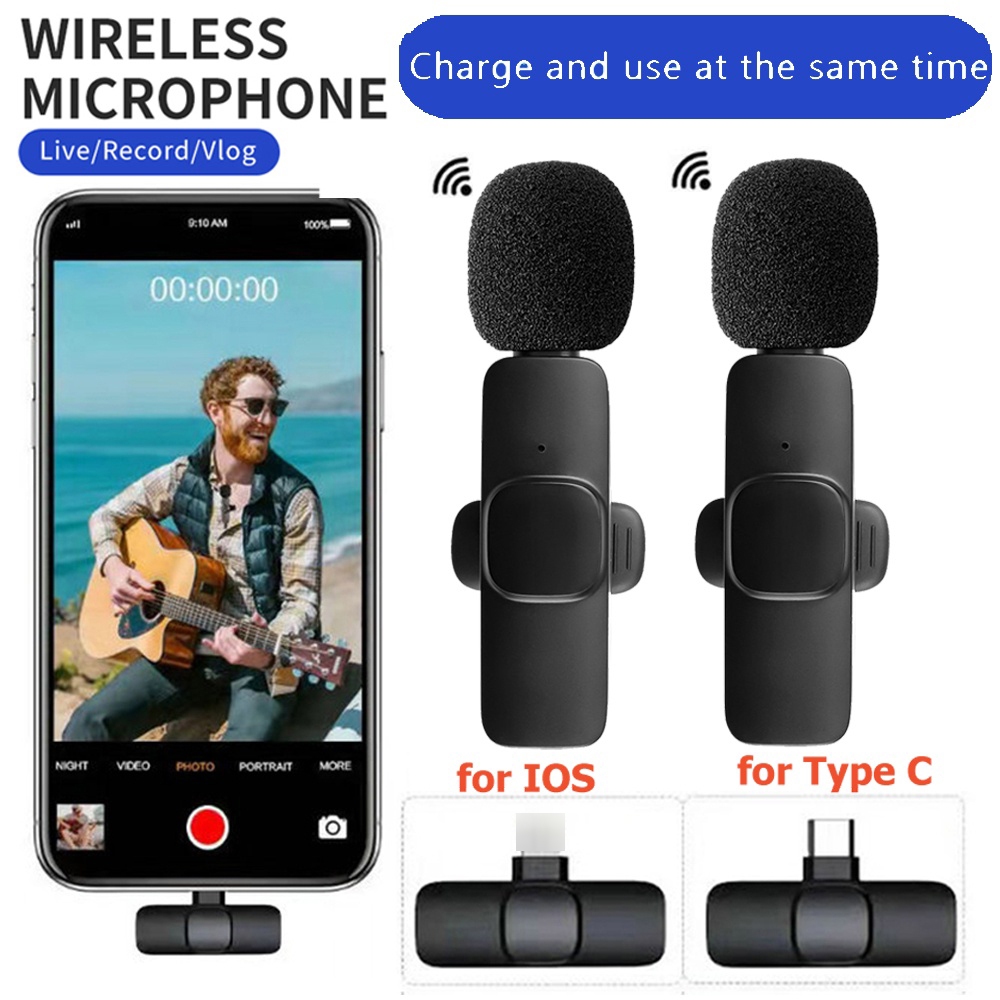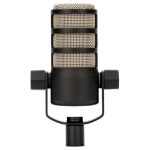Comparing lavalier and handheld wireless microphones for podcasting reveals a fascinating dichotomy in audio capture. The seemingly simple choice between clipping a mic onto your shirt or holding one in your hand actually impacts sound quality, versatility, ease of use, cost, and even the visual aesthetic of your podcast. This exploration delves into the nuanced differences between these two popular microphone types, helping you choose the best option for your specific podcasting needs and style.
From the crisp clarity of a well-placed lavalier to the robust presence of a handheld microphone, each option presents unique advantages and disadvantages. We will analyze sound quality, considering factors like frequency response and background noise rejection. We’ll then examine the practical aspects: setup, ease of use, and cost-effectiveness. Finally, we’ll consider the visual impact each microphone type has on your podcast’s presentation, ensuring your audio and video (if applicable) work in harmony.
Sound Quality Comparison

Choosing between a lavalier and a handheld wireless microphone for your podcast hinges significantly on the desired sound quality. Both microphone types offer distinct advantages and disadvantages depending on the recording environment and the desired aesthetic. This section will delve into a detailed comparison of their audio characteristics.
Lavalier microphones, being closer to the sound source (the speaker’s mouth), generally offer better clarity and reduce background noise. However, this proximity can also accentuate plosives (hard consonant sounds like ‘p’ and ‘b’) and mouth noises. Handheld microphones, while offering more distance, can be susceptible to handling noise and variations in distance from the speaker’s mouth, impacting consistency. The frequency response also differs, with lavaliers often exhibiting a more focused response, while handheld microphones might have a broader range, potentially capturing more ambient sound.
Proximity’s Impact on Sound Quality
The distance between the microphone and the sound source is paramount. A lavalier microphone, clipped close to the speaker’s collar, minimizes the impact of room reverberation and captures a more intimate, clear sound. This is ideal for interviews or solo podcasts where a natural, close-miked sound is preferred. Conversely, a handheld microphone, held at varying distances, will exhibit inconsistent sound levels and increased susceptibility to background noise.
In a noisy environment, a lavalier microphone, placed correctly, will generally provide a cleaner audio signal than a handheld microphone held several inches from the mouth. However, if a handheld microphone is used consistently at the same distance, its sound quality can be comparable, but it requires more discipline from the user.
Frequency Response, Sensitivity, and Signal-to-Noise Ratio Comparison
The following table summarizes typical characteristics of lavalier and handheld wireless microphones. Note that these are general comparisons and specific models will vary. The values presented are representative averages based on data from various reputable microphone manufacturers.
| Characteristic | Typical Lavalier Microphone | Typical Handheld Microphone | Units |
|---|---|---|---|
| Frequency Response | 50Hz – 16kHz | 40Hz – 18kHz | Hz |
| Sensitivity | -40dBV/Pa | -50dBV/Pa | dBV/Pa |
| Signal-to-Noise Ratio | 70dB | 65dB | dB |
For example, a high-quality lavalier microphone like the Shure MV88+ with a frequency response of 20Hz-20kHz will capture a much wider range of frequencies compared to a less expensive handheld microphone. This results in a richer and more detailed sound. Similarly, a Rode Wireless GO II lavalier system, known for its low noise floor, will typically exhibit a higher signal-to-noise ratio than a less sophisticated handheld system, leading to a cleaner recording.
Versatility and Use Cases

Lavalier and handheld wireless microphones, while both offering wireless freedom for podcasting, cater to different needs and styles. Their versatility hinges on the specific demands of the recording environment and the podcast format itself. Understanding these differences is crucial for selecting the optimal microphone for a given project.The choice between a lavalier and a handheld microphone often boils down to the desired level of mobility, the number of participants, and the overall aesthetic of the podcast.
Choosing between lavalier and handheld wireless microphones for podcasting often depends on personal preference and recording style. However, regardless of your choice, optimizing audio quality is crucial. For detailed guidance on this, check out this helpful guide on how to improve wireless microphone audio quality for live streaming , which offers valuable insights applicable to podcasting as well.
Ultimately, the best microphone choice hinges on achieving the clearest, most professional sound for your podcast.
A lavalier microphone, being unobtrusive, is ideal for situations where a natural, less visually distracting recording is paramount. Conversely, a handheld microphone emphasizes the speaker, making it a better fit for presentations or discussions where the speaker’s presence is a central element.
Lavalier and Handheld Microphone Suitability for Different Podcast Formats
Lavalier microphones are particularly well-suited for interview-based podcasts, where the focus is on the conversation rather than the visual presentation of the speakers. Their discreet nature allows for a more natural and intimate feel. They also excel in solo podcasts where the host needs freedom of movement while recording. Conversely, handheld microphones are often preferred for panel discussions or podcasts with multiple hosts where each participant needs their own microphone for optimal audio capture and to avoid crosstalk.
They are also a great choice for podcasts with a more formal or traditional feel, such as lectures or presentations. The visual presence of the microphone contributes to the overall aesthetic.
Situations Favoring Lavalier or Handheld Microphones, Comparing lavalier and handheld wireless microphones for podcasting
Lavalier microphones are the preferred choice when recording in environments where minimal visual distraction is desired. For example, an interview conducted in a natural setting like a coffee shop would benefit from a lavalier, as it avoids drawing attention away from the conversation. Conversely, a handheld microphone is ideal for a podcast with a more structured format, such as a live recording in front of an audience, where the microphone itself becomes a visual component of the presentation.
This also applies to scenarios where the presenter or interviewee needs to move around a lot during the recording. A handheld allows for more flexibility than a fixed lavalier.
Pros and Cons of Lavalier and Handheld Microphones in Podcasting Scenarios
The following points summarize the advantages and disadvantages of each microphone type in various podcasting contexts:
It’s important to note that these are general guidelines, and the optimal choice will always depend on the specific circumstances of each podcast.
- Lavalier Microphones:
- Pros: Discreet, allows for freedom of movement, ideal for interviews and solo shows where visual distraction needs to be minimized, less likely to pick up handling noise.
- Cons: Can be easily bumped or dislodged, may require careful placement for optimal sound quality, less robust than handheld microphones, may require additional accessories like a lavalier clip.
- Handheld Microphones:
- Pros: Robust, easily controlled by the speaker, ideal for panel discussions and presentations, visually prominent, less susceptible to accidental damage.
- Cons: Restricts movement, can pick up handling noise if not handled carefully, less suitable for intimate interviews, requires more careful handling to avoid unwanted sounds.
Ease of Use and Setup: Comparing Lavalier And Handheld Wireless Microphones For Podcasting

Setting up and using wireless microphones for podcasting can vary significantly depending on the type of microphone chosen. Lavalier microphones, known for their discreet nature, often present a different set of challenges compared to the more straightforward handheld units. This section will delve into the ease of use and setup for both, highlighting potential technical hurdles and offering step-by-step guides for a smooth recording experience.Lavalier microphones, while small and unobtrusive, require more meticulous setup and attention to detail to ensure optimal sound quality.
Handheld microphones, conversely, tend to be more user-friendly due to their simpler design and readily accessible controls. However, both types require a basic understanding of wireless microphone technology.
Lavalier Microphone Setup
Setting up a lavalier microphone involves several key steps. First, securely attach the microphone to clothing, ensuring it’s positioned close to the mouth but not rubbing against it. This often requires using clips or adhesive patches. Next, connect the microphone to the transmitter. This typically involves a small connector, often a mini-XLR or proprietary connector.
Then, power on both the transmitter and receiver, ensuring they are properly paired. Finally, adjust the gain levels on both the transmitter and the recording device to achieve optimal audio levels, avoiding clipping or excessive noise. Common technical challenges include ensuring a secure connection to prevent interference or audio dropouts, and managing the placement of the microphone to minimize handling noise and clothing rustle.
- Attach the lavalier microphone to clothing using a clip or adhesive patch, ensuring it’s positioned close to the mouth but not rubbing.
- Connect the lavalier microphone to the transmitter using the appropriate connector.
- Power on both the transmitter and receiver, ensuring they are properly paired. This usually involves selecting the same channel on both units.
- Adjust the gain levels on both the transmitter and your recording device (e.g., audio interface, computer) to achieve optimal audio levels, monitoring for clipping (distortion) or excessive background noise.
- Test the microphone by speaking into it and checking the audio levels on your recording device.
Handheld Microphone Setup
Setting up a handheld wireless microphone is generally simpler. Begin by powering on both the transmitter and receiver, ensuring they are on the same channel. Then, hold the microphone and speak into it, adjusting the gain on the receiver and recording device as needed. Technical challenges might include accidentally muting the microphone or experiencing interference from other wireless devices operating on the same frequency.
Battery life is also a factor to consider with handheld units.
- Power on both the transmitter and receiver, ensuring they are paired and on the same channel.
- Hold the microphone and speak into it, ensuring you maintain a consistent distance and angle.
- Adjust the gain levels on the receiver and your recording device to achieve optimal audio levels, monitoring for clipping or excessive background noise.
- Test the microphone by speaking into it and checking the audio levels on your recording device.
- Monitor battery life and replace batteries as needed.
Equipment Comparison
The following table compares the required equipment for both lavalier and handheld wireless microphone systems.
| Component | Lavalier Microphone System | Handheld Microphone System | Notes |
|---|---|---|---|
| Microphone | Lavalier microphone (e.g., miniature condenser microphone) | Handheld microphone (e.g., dynamic microphone) | Different microphone types offer varying sound characteristics. |
| Transmitter | Bodypack transmitter (with connector for lavalier mic) | Built-in transmitter within the handheld microphone | Bodypack transmitters often have belt clips. |
| Receiver | Wireless receiver (typically 1/4″ or XLR output) | Wireless receiver (typically 1/4″ or XLR output) | Receivers connect to your audio interface or recording device. |
| Accessories | Microphone clips, adhesive patches, possibly windscreen | Possibly a windscreen or shock mount | Accessories enhance sound quality and microphone protection. |
Cost and Budget Considerations
Choosing between a lavalier and handheld wireless microphone for your podcast often comes down to more than just sound quality; budget plays a significant role. Understanding the cost implications of each type, both upfront and over the long term, is crucial for making an informed decision. This section will explore the typical price ranges and long-term maintenance costs associated with each microphone type.
The price difference between lavalier and handheld wireless microphones of comparable quality can be substantial, influenced by several factors. High-end models from established brands often command higher prices due to superior components, advanced features like digital signal processing (DSP), robust build quality, and more extensive warranties. Furthermore, the included accessories, such as extra transmitters, receivers, and carrying cases, can also significantly affect the overall cost.
Lavalier microphones, being smaller and often simpler in design, generally have a lower entry point, though professional-grade options can still reach prices comparable to high-end handheld systems.
Price Ranges for Lavalier and Handheld Wireless Microphones
The following table Artikels typical price ranges for entry-level, mid-range, and professional-grade lavalier and handheld wireless microphone systems. These are broad estimates, and actual prices can vary depending on the specific brand, model, and retailer.
| Microphone Type | Entry-Level | Mid-Range | Professional |
|---|---|---|---|
| Lavalier Wireless | $50 – $150 | $150 – $400 | $400 – $1000+ |
| Handheld Wireless | $100 – $300 | $300 – $800 | $800 – $2000+ |
Long-Term Cost Implications
Beyond the initial purchase price, consider the ongoing costs associated with each microphone type. Lavalier microphones, being smaller and more delicate, are potentially more susceptible to damage, requiring replacements more frequently than more robust handheld microphones. Handheld mics, while generally more durable, may require occasional repairs or battery replacements. Furthermore, the cost of accessories like extra batteries, charging docks, or windshields should be factored into the overall long-term budget.
For example, a mid-range lavalier system might need a replacement transmitter after a year due to accidental damage, adding another $100-$200 to the overall cost. A comparable handheld system, however, might last significantly longer, potentially reducing long-term maintenance costs.
Visual Considerations and Aesthetics
The visual impact of your microphone choice on your podcast significantly influences the viewer experience, especially for video podcasts. A microphone’s size, placement, and overall aesthetic contribute to the overall production value and professionalism of your show. Let’s examine how lavalier and handheld microphones differ visually.
Lavalier Microphone Visual Impact
Lavalier microphones, due to their small size and discreet nature, generally have minimal visual impact. Their small size allows for near-invisibility when clipped to clothing, minimizing distractions for the viewer. This unobtrusive presence keeps the focus on the speaker and the content, leading to a cleaner and more polished visual aesthetic. However, improper placement can lead to a noticeable bump or wire visibility, detracting from the overall look.
A strategically placed lavalier microphone can seamlessly integrate into the visual presentation, allowing viewers to focus on the speaker and their message without visual clutter. For instance, a black lavalier microphone clipped discreetly under a dark shirt will be almost invisible.
Handheld Microphone Visual Impact
Handheld microphones, conversely, are significantly more prominent in the visual presentation. Their size and the fact that they are actively held by the speaker make them a central visual element. The design of the microphone itself—whether it’s a sleek, modern design or a more classic, vintage-style microphone—can influence the overall aesthetic of the video. A high-quality, professional-looking handheld microphone can add a sense of sophistication and polish to the production.
Conversely, a cheap-looking handheld microphone might detract from the overall professional image. The way the speaker holds the microphone also affects the visuals; a confident, controlled grip can enhance the presentation, while an awkward or shaky hold can be distracting. Imagine a presenter confidently delivering a speech using a classic, chrome-finished Neumann U 87 Ai. The visual impact is far different from a presenter holding a cheap plastic microphone.
Microphone Placement and Viewer Experience
The placement of both microphone types significantly impacts viewer experience. A poorly placed lavalier microphone, for example, might be visible and distracting, drawing attention away from the speaker’s face and message. Similarly, a handheld microphone held too low or too high can obstruct the speaker’s face or appear unnatural. Optimal placement for a lavalier microphone is generally just below the collarbone, hidden from the camera’s view as much as possible.
For handheld microphones, consistent and natural holding is crucial. Inconsistent positioning can appear unprofessional and disruptive to the viewer’s focus. The overall goal should be to minimize the visual intrusion of the microphone while ensuring optimal audio capture.
Visual Differences in Microphone Appearance
Lavalier microphones are typically small, often less than an inch in length and diameter, and are designed to be inconspicuous. They are usually clipped onto clothing and come in various colors to match the speaker’s attire. Handheld microphones, on the other hand, are significantly larger, ranging from several inches to over a foot in length, depending on the model.
Their designs vary widely, from simple, utilitarian models to more elaborate and aesthetically pleasing designs. They are often characterized by their substantial size and the presence of a prominent microphone capsule. The material used, be it metal, plastic, or a combination, also influences their visual appearance and perceived quality.
Last Recap
Ultimately, the best wireless microphone for your podcast depends on a careful consideration of your specific needs and priorities. While lavalier microphones offer discreet, high-quality audio capture ideal for interviews and solo shows, handheld microphones provide a more dynamic and engaging presence for panel discussions and performances. By weighing the factors of sound quality, versatility, ease of use, cost, and visual aesthetics, you can make an informed decision that enhances the production value and overall listening experience of your podcast.
FAQ
What is the difference in battery life between lavalier and handheld wireless microphones?
Battery life varies greatly depending on the specific model and manufacturer. Generally, smaller lavalier transmitters tend to have shorter battery life than larger handheld transmitters. Always check the manufacturer’s specifications for precise details.
Can I use a lavalier microphone for a live podcast recording?
Yes, lavalier microphones are suitable for live recordings, provided you have a reliable wireless system with sufficient range and a robust signal. Consider potential interference and environmental factors that might affect the audio quality.
How important is the quality of the wireless receiver in a podcast setup?
The receiver is crucial for a clear, interference-free signal. Investing in a high-quality receiver with features like diversity reception (receiving signals from multiple antennas) can significantly improve audio quality and reliability, especially in environments with potential interference.
What type of cable is needed for connecting a lavalier microphone to a wireless transmitter?
Lavalier microphones typically use a TA4F (mini XLR) connector to connect to the transmitter. However, some models may use different connectors; always check the manufacturer’s specifications for compatibility.

